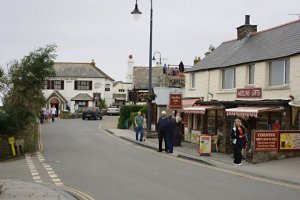


Village dedicated to King Arthur
Web: www.tintagelweb.co.uk
Web: www.visitcornwall.com/destinations/tintagel
Arthur Mee's "Kings England" commences with "It is a bit of the magic of England, and seems to us as wonderful in truth as in imagination." "Its rocks rise sheer from the sea, crowned with green carpets. Cornwall's oldest church still holding services, looks down upon the Atlantic, sweeping in below." "When the wind blows, that we may lean on it, and the sea breaks on million year old granite walls, it will thrill an Englishman as few things do."
That brief description slightly updated, is probably the most accurate from any of our great authors, and although that was written over fifty years ago, the natural aspects of Tintagel have not changed one bit. The legend of King Arthur attracts visitors of all nationalities to Tintagel, and there are numerous places of interest in the surrounding area. The shops of Tintagel can cope with all the needs of the holidaymaker. There is a wide variety of accommodation, restaurants, character pubs and quality retail outlets.
Tintagel is midway between Bude and Padstow on the north Cornish coast and along with Boscastle sits on the B3263. The population of the village was 1,727 at the 2011 census.
Tintagel owes much of its popularity to its links to the famous Arthurian legend. A walk down the main street quickly shows the town has capitalised on the legend, King Arthur, Pendragon, Excalibur and Merlin are names that greet you from practically every shop and curio.
Also on the High Street although not connected with King Arthur is The Old Post Office, which is now owned by the National Trust. This one time small manor house dates form the 14th century and it is possible to see the stone paved medieval hall complete with an ancient fireplace. It was used as a Post Office in the 19th century until being purchased by the National Trust for the princely sum of £100.
The parish church of St. Materiana which stands on the cliffs between Trevena and Tintagel Castle was built in Norman times but the tower may be 13th or 15th century in date. The site offers amazing views up and down the coast.
Romantic stories linking Tintagel Castle to the Round Table, knights and chivalry are exciting and magical but little is based on historical fact. The first link to the legend was in 1130 when Geoffrey de Monmouth published the 'History of Britain' and claimed that Tintagel was the birthplace of King Arthur.
The wondrous setting of Tintagel Castle inspires the imagination and the headland upon which the castle stands is proudly majestic with the turbulent Atlantic Ocean beating against its three sides. Ancient rock cut graves have revealed that the headland was once inhabited by a small Celtic community of monks.
The most notable of the hotels is the King Arthur's Castle Hotel (Castle Hotel) (more recently the Camelot Castle Hotel) which was an enterprise of Sir Robert Harvey and opened in 1899: the architect was Silvanus Trevail. It stands alone on land previously known as Firebeacon and many fine building stones were used in its construction.
The historic buildings such as The Old Post Office, St. Materianas Church, Tintagel Castle, King Arthur's Hall of Chivalry, and the Chapel of Our Lady of Fontevrault, are worth more than just a day visit. Complemented by the hamlets of Treknow, Tregatta, and Trewarmett and many other places to explore, Tintagel is an ideal base for holidaymakers all year round. Many of the hotels, guest houses and self catering establishments are open all year, so you will always find a friendly reception and comfortable stay. The late Poet Laureate, Sir John Betjeman, said, "This salty sea coast parish is best seen out of season, and on a stormy day." He was most enthusiastic with regard to architecture, and found plenty to enjoy He too, like many of the more discerning visitors, enjoyed the natural and spectacular coves and rock formations, especially between Tregardock and Boscastle, probably the world's finest coastline.
Near Dunderhole Point on Glebe Cliff stands a building from the former slate quarry: this has been used as Tintagel Youth Hostel for many years.
On Friday July 6th 1979, villagers and holidaymakers had a miraculous escape when an out of control RAF fighter jet ploughed into the village just yards away from a loaded petrol tanker. The pilot, who was on a training flight, experienced control difficulties and had to eject into the sea leaving his Hawker Hunter jet to crash into the ocean. Instead it veered towards land, hurtling at 250mph, a major disaster seemed inevitable. But it was nothing short of a miracle when the jet ended up wedged in a twelve foot gap between Klymiarven Guest house and King Arthur's Terrace, damaging just three cars, a greenhouse and a swimming pool in it's wake.
Henry George White, the village schoolmaster for many years was also a prolific amateur painter.
Harry Cann (1905-1980) was a footballer who played for Plymouth Argyle (as goalkeeper).
The Very Reverend Clifford Piper (1953-), Dean of Moray, Ross and Caithness was born at Tintagel.
It was also the occasional residence of John Douglas Cook (1808-1868), founder editor of the Saturday Review who is buried at Tintagel. He bought Trevena House as an occasional residence: it later became the front part of King Arthur's Great Halls.
Tintagel Carnival - Early August
Boscastle Bossiney Camelford Delabole Port Gaverne Port Isaac St. Nectan's Glen Trebarwith Strand
Tintagel Youth Hostel The Arthurian Centre Tintagel Visitor Centre The Coastal Footpath
Merlin's Cave The Old Post Office Tintagel Castle King Arthur's Great Halls